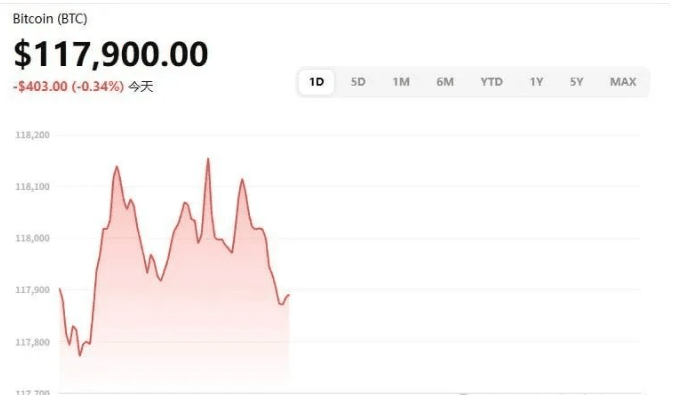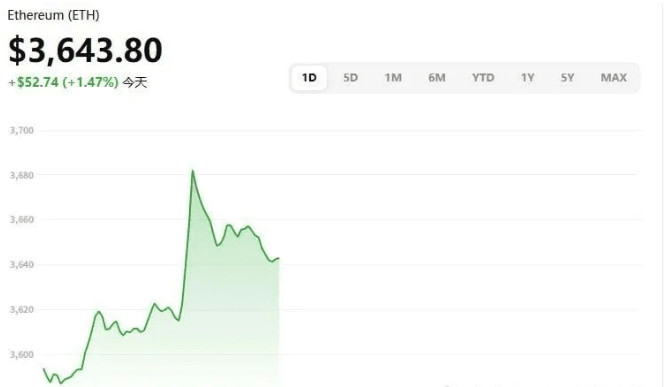Following the passage of significant crypto regulatory legislation in the U.S., investor sentiment has been significantly boosted, and large amounts of funds are accelerating into the digital asset market. As of July 19, CoinGecko data shows that the overall market cap of the crypto market has first exceeded $4 trillion, setting a historical high. This important milestone marks a strong recovery since the FTX incident in 2022, when the market once fell to about $800 billion, and the price of Bitcoin also hit a low of $16,000.
Currently, although the price of Bitcoin has slightly retraced, it remains in a high volatility range. As of July 20, 2025, the BTC price is approximately $117,900, with daily fluctuations between $117,500–$118,500, showing a slight decline of 0.3%.

Bitcoin analysis: Adjustment accumulation, challenges to new highs are still expected
In terms of technical trends, Bitcoin strongly broke through the $120,000 mark in early July and briefly touched a high of $123,000 on the 14th. The current slight pullback is generally seen as a temporary correction, with a structural bullish trend still maintaining well.
On the policy front, the 'Crypto Week' legislation promoted by the U.S. Congress is under review, covering two key bills, the GENIUS Act and the CLARITY Act, which are seen as significant steps towards clear regulation of crypto assets in the U.S. Additionally, the executive order on 'National Bitcoin Strategic Reserve' signed by Trump has also enhanced market confidence in long-term growth.
Capital flow data is also strong. Bernstein's report indicates that institutional net purchases of BTC have exceeded $5 billion this year, including financial giants like BlackRock and Fidelity gradually incorporating BTC into their strategic asset portfolios. Galaxy Digital analysts expect that if this trend continues, Bitcoin is likely to challenge historical highs again before the end of the month.
Short-term outlook: BTC is expected to consolidate in the $118k–121k range, and if it stabilizes, it may challenge above $123k–125k.
Medium-term target: Institutions such as Bernstein and CryptoQuant are generally bullish, predicting a potential rise to $140k by the end of the year, with aggressive scenarios pointing to $200k. If market sentiment cools, support for a pullback may be around $110k–112k.
Ethereum: Continuous capital inflow, clear rebound trend
The current price of ETH is $3,643.8, up about 1.47% in the past 24 hours, with fluctuations between $3,540–3,682. Since July, the Ethereum ETF has been active in North America, with a maximum daily capital inflow of up to $7.49B, attracting over $2 billion in new capital.

In terms of price performance, since hitting the bottom at the end of June, ETH has rebounded over 40% and broke through $3,600 this week, reaching a six-month high. The chart structure shows a typical 'cup and handle' pattern, with further upward potential widely viewed positively.
On-chain data also supports the upward logic — in the past 12 days, ETH on-chain transaction volume has increased by about 280%, with an average daily transaction volume of $50B, indicating that whales and retail investors are entering the market simultaneously. Large mining companies like BitMine Immersion are also significantly increasing their positions around $3,675.
ETH market outlook and risk warning
Support level: $3,400 is the key bullish defense line; if it falls below $3,300, it may adjust to $3,200 in the short term;
Resistance range: $3,800–4,100 is the medium-term target, with further breakthroughs or challenges to $5,000 or even higher;
Optimistic forecast: If the ETF continues to attract funds and favorable policies are implemented, TokenMetrics predicts it may hit $10,000 by the end of the year.
Risk warning and strategy advice
Short-term defense focuses on whether BTC can maintain above the 20-day EMA (around $112k) and whether ETH can hold above $3,400;
If legislative progress slows and macro policies (such as interest rate hikes by the Federal Reserve) tighten, significant market fluctuations may occur;
It is recommended to set reasonable take-profit and stop-loss levels, and to pay attention to changes in market trading volume and on-chain capital inflow rhythm.
The market is rising, and risks are accumulating. The higher the position, the more one must stabilize their mindset. Controlling positions, setting stop losses, and paying attention to macro policies and on-chain data are essential skills for investors. In the face of rapid rotation and structural changes, blindly chasing highs is less effective than rational layout. A bull market is likely still on the way, but those who go far will certainly be steady. Following the passage of significant crypto regulatory legislation in the U.S., investor sentiment has been significantly boosted, and large amounts of funds are accelerating into the digital asset market. As of July 19, CoinGecko data shows that the overall market cap of the crypto market has first exceeded $4 trillion, setting a historical high. This important milestone marks a strong recovery since the FTX incident in 2022, when the market once fell to about $800 billion, and the price of Bitcoin also hit a low of $16,000.
Currently, although the price of Bitcoin has slightly retraced, it remains in a high volatility range. As of July 20, 2025, the BTC price is approximately $117,900, with daily fluctuations between $117,500–$118,500, showing a slight decline of 0.3%.

Bitcoin analysis: Adjustment accumulation, challenges to new highs are still expected
In terms of technical trends, Bitcoin strongly broke through the $120,000 mark in early July and briefly touched a high of $123,000 on the 14th. The current slight pullback is generally seen as a temporary correction, with a structural bullish trend still maintaining well.
On the policy front, the 'Crypto Week' legislation promoted by the U.S. Congress is under review, covering two key bills, the GENIUS Act and the CLARITY Act, which are seen as significant steps towards clear regulation of crypto assets in the U.S. Additionally, the executive order on 'National Bitcoin Strategic Reserve' signed by Trump has also enhanced market confidence in long-term growth.
Capital flow data is also strong. Bernstein's report indicates that institutional net purchases of BTC have exceeded $5 billion this year, including financial giants like BlackRock and Fidelity gradually incorporating BTC into their strategic asset portfolios. Galaxy Digital analysts expect that if this trend continues, Bitcoin is likely to challenge historical highs again before the end of the month.
Short-term outlook: BTC is expected to consolidate in the $118k–121k range, and if it stabilizes, it may challenge above $123k–125k.
Medium-term target: Institutions such as Bernstein and CryptoQuant are generally bullish, predicting a potential rise to $140k by the end of the year, with aggressive scenarios pointing to $200k. If market sentiment cools, support for a pullback may be around $110k–112k.
Ethereum: Continuous capital inflow, clear rebound trend
The current price of ETH is $3,643.8, up about 1.47% in the past 24 hours, with fluctuations between $3,540–3,682. Since July, the Ethereum ETF has been active in North America, with a maximum daily capital inflow of up to $7.49B, attracting over $2 billion in new capital.

In terms of price performance, since hitting the bottom at the end of June, ETH has rebounded over 40% and broke through $3,600 this week, reaching a six-month high. The chart structure shows a typical 'cup and handle' pattern, with further upward potential widely viewed positively.
On-chain data also supports the upward logic — in the past 12 days, ETH on-chain transaction volume has increased by about 280%, with an average daily transaction volume of $50B, indicating that whales and retail investors are entering the market simultaneously. Large mining companies like BitMine Immersion are also significantly increasing their positions around $3,675.
ETH market outlook and risk warning
Support level: $3,400 is the key bullish defense line; if it falls below $3,300, it may adjust to $3,200 in the short term;
Resistance range: $3,800–4,100 is the medium-term target, with further breakthroughs or challenges to $5,000 or even higher;
Optimistic forecast: If the ETF continues to attract funds and favorable policies are implemented, TokenMetrics predicts it may hit $10,000 by the end of the year.
Risk warning and strategy advice
Short-term defense focuses on whether BTC can maintain above the 20-day EMA (around $112k) and whether ETH can hold above $3,400;
If legislative progress slows and macro policies (such as interest rate hikes by the Federal Reserve) tighten, significant market fluctuations may occur;
It is recommended to set reasonable take-profit and stop-loss levels, and to pay attention to changes in market trading volume and on-chain capital inflow rhythm.
The market is rising, and risks are accumulating. The higher the position, the more one must stabilize their mindset. Controlling positions, setting stop losses, and paying attention to macro policies and on-chain data are essential skills for investors. In the face of rapid rotation and structural changes, blindly chasing highs is less effective than rational layout. A bull market is likely still on the way, but those who go far will certainly be steady.


